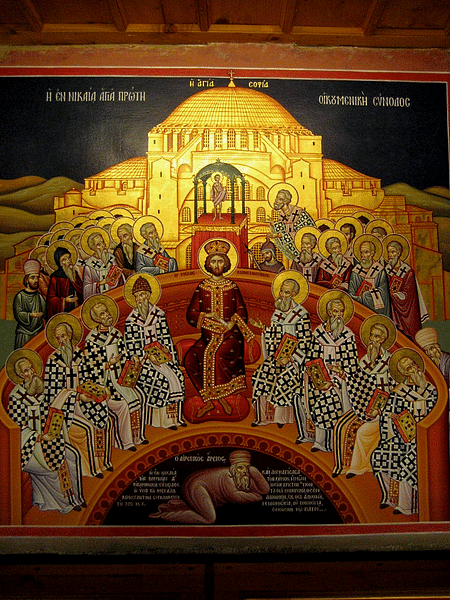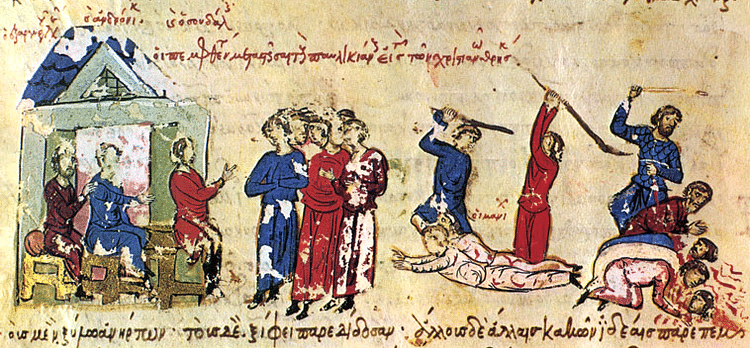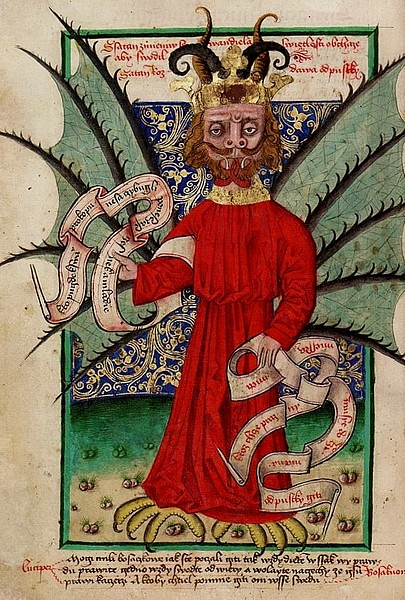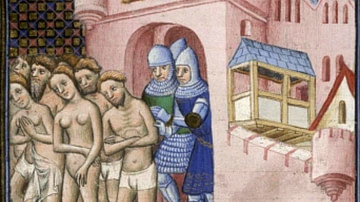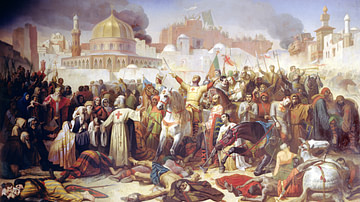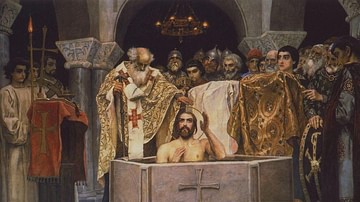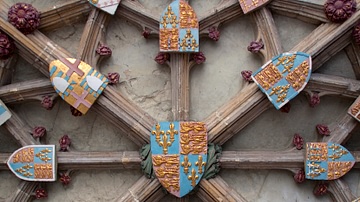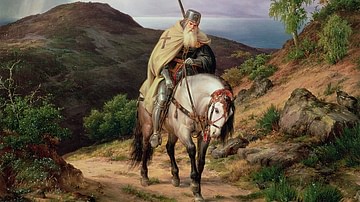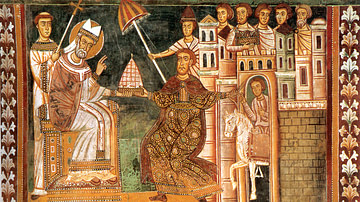The medieval Church established its monopoly over the spiritual life of Europeans in the Early Middle Ages (c. 476-1000) and consolidated that power throughout the High Middle Ages (1000-1300) and Late Middle Ages (1300-1500). Along the way, the clergy became increasingly corrupt, ignored basic tenets of Christianity, and often lived lavishly on the tithes of the people.
Parish priests became so synonymous with hypocrisy and sin that anti-clericalism was common throughout Europe well before the High Middle Ages and contributed to the development of alternative belief systems that the Church condemned as heresies.
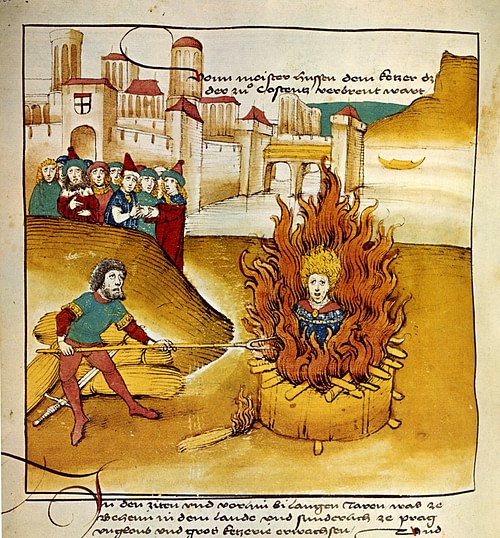
There was little else the common people – or even the nobility – could do about clerical corruption because the Church held the keys to one's eternal destination. One could only attain salvation and eternal life by following the precepts of the Church, and one's alternative was an eternity in the torments of hell or a limited, but almost equally unpleasant, stay in the fires of purgatory where one's sins were burnt away. Heaven, hell, and purgatory were regarded as absolute certainties after death and, since the Church made all the rules regarding where a soul would wind up, people were forced to accept the clergy's often atrocious behavior.
The Christian mass was recited in Latin, the Bible was in Latin, and prayers such as the Our Father and Hail Mary were taught to parishioners and memorized in Latin – a language none of the peasantry and few of the nobility understood. Christ's ministry, as recorded in the gospels of the Bible, was therefore the sole property of the clergy who claimed only the Church could rightly understand the intentions of God and interpret them for others.
The Catholic Church was the only recognized form of Christianity for those Europeans not aligned with the Eastern Orthodox Church until the Protestant Reformation (1517-1648) broke its power. Prior to the Reformation, however, so-called heresies offered the opportunity for religious expression outside of the narrowly defined precepts of the Church.
The Heretics
Although Europe was nominally orthodox Christian throughout the Middle Ages, there were a number of movements which questioned the Church's teachings and sought to establish their own version of Christianity or, as in the case of the Paulicians, Bogomils, and Cathars, a kind of sister-religion which drew on the tenets of Persian Manichaeism, Greek Gnosticism, and Christianity. These movements were condemned as heresies and were ruthlessly crushed by the medieval Catholic Church.
Although there were many so-called heretical movements throughout the Middle Ages, these six had the greatest impact and would inspire others:
- Paulicians
- Bogomils
- Cathars
- Waldensians
- Lollards
- Hussites
All six of these were suppressed by the Church, often resulting in the slaughter of populations which had nothing to do with the heresy, as the Church continued to insist on its spiritual authority as the representative of God on earth. To the Church, which maintained and stoked the terror of their vision of hell and purgatory, a heretic was akin to someone with a contagious disease who had to be kept away from the general population to keep the disease from spreading while efforts were made to cure them.
These initial efforts relied on words – missionaries who would debate with heretics to win them back to orthodoxy – but it became apparent that heretics were often better at debate than the Catholic clergy, and so more serious measures were instituted, which would finally result in devastations such as the Albigensian Crusade of 1209-1229 and the infamy of the medieval inquisitions.
Early Heretics & Nicaea
Christianity between the 1st and 4th centuries was interpreted differently by various religious factions. After Constantine the Great (r. 306-337) legitimized Christianity, he demanded a unified vision for the new faith which was attempted at the first Council of Nicaea in 325 CE. Prior to this, the teachings of Arius of Alexandria (l. 256-336) – who denied the validity of the Christian Trinity among other orthodox beliefs – were as valid as any other form of Christianity.
The Ebionites of the 4th century, among others, denied Christ's divinity and adhered to the belief known as Adoptionism whereby Jesus of Nazareth, a sinless man, was "adopted" by God through his baptism, death, and resurrection but was not "the only begotten son of God". The Donatists of 4th-century North Africa claimed that the Christian clergy must itself be sinless in emulation of Christ and his apostles and so any clergy tainted by sin should be barred from administering rites or celebrating the mass.
Constantine believed he had received a vision from Jesus Christ just before the decisive Battle of the Milvian Bridge in 312 at which he defeated his rival Maxentius and assumed full power as Roman emperor. Christ appeared to him in the same way that pagan gods of the past had and so Christ was obviously a god of superior power. Constantine was not, therefore, interested in a vision of Christianity which denied Christ's divinity nor was he about to tolerate what he considered the nitpicking of the Donatists or the adoptionism of the Ebionites and others. These were condemned at Nicaea and an orthodox platform of belief established.
Among the many changes Nicaea initiated was the second-class status of women in the Church who were henceforth to be considered laypersons who might assist in Church functions but could not teach or hold authority over men. Prior to Nicaea, there are records of many influential and quite powerful women in the Church whose work was just as significant, often more so, than any of their male counterparts. The exclusion of women from positions of power was simply another aspect of establishing an orthodox vision of Christianity, and once there was only one right way to interpret and practice the faith, any other was a heresy which had to be suppressed.
The Church & Temporal Power
The Church wielded temporal power through secular means since Constantine and his immediate successors considered themselves Christian champions. Since the Church was tax exempt, it could amass considerable wealth, and since it also demanded one-tenth of a believer's income as a tithe, this wealth grew and translated into land and power. In the 8th century, the Church took another step to increase its supremacy through the forgery known as The Donation of Constantine which claimed that Constantine the Great had surrendered his power to the pope who then allowed the emperor to reign by his good graces. Temporal power - according to the Church - actually belonged to the pope and was only on loan to whatever monarch might reign at a given time.
The actual impact of this document throughout most of the Middle Ages is debated, but the concept behind it – and the Church's increasing involvement in the affairs of the state – was significant. It encouraged Pepin the Short, King of the Franks (r. 751-768) to make his own gift to the Church of The Donation of Pepin which gave the lands he had conquered from the Lombards to the Church and established the Papal States. The Church could also raise its own militia, engage in military campaigns, and – since they claimed to be the power behind any throne – bully monarchs into complying with its interests.
The Church's involvement with secular matters concerned many people and outraged many others. In medieval Italy, the factions known as the Guelphs and Ghibellines arose in the 12th century in response to the Investiture Controversy (whereby the Church could appoint high officials without consulting the king). The Guelphs supported papal supremacy while the Ghibellines supported the Holy Roman Emperor. The Ghibellines, however, never came out against the Church itself, only against perceived abuses of power, while heretical sects condemned the Church's hypocrisy, undeserved wealth, and all its other manifestations of corruption as well as denying the legitimacy of the papacy, clergy, and even the sacraments.
Six Great Medieval Heresies
The sacraments included baptism, confirmation, communion, penance, marriage, holy orders, and anointing the sick (also known as last rites). One needed to observe the sacraments in order to be considered a Christian in God's grace, and these rites had to be administered by the Catholic clergy to be valid. The Church charged people for each of these rituals and, if one could not pay cash, one had to volunteer one's time in service to the church. It was noted by some, however, that the clergy itself was living quite well and seemed far less concerned with their own level of service than acquiring luxury items and living in comfort.
Any complaints against this kind of behavior were criticisms of the Church itself and could not be tolerated. The recognition of any criticism would have required reform, and the Church had no interest in that. Even so, significant members of the clergy did call the Church to account, such as the priest and scholar Peter Abelard (l. 1079-1142) who claimed that dialectic (the practice of investigating the truth of a proposition rationally) should be applied not only to the Church sacraments but to Church policies and even to the Bible itself. Abelard was condemned as a heretic, his book burned, and he was forced to recant.
Other so-called heretics took their cause to the people who frequently embraced the new ideas before they were crushed by the Church. The nobility, especially, welcomed an alternative to the Catholic Church in the hope that whatever institution might topple it would be less intrusive in their own affairs. The following six belief systems began as reactions to the corruption of the Church and developed their own vision of spirituality and the Divine.
Paulicians (7th-9th centuries) were founded in Armenia by Constantine-Silvanus (d. 684) and encouraged direct communication with God through prayer. They advocated a return to the simplicity and communion of early Christianity as expressed in the life of Saint Paul (l. c. 5- c. 67). They had no churches and met in the homes of adherents which they called “Places of Prayer”. They were a dualist faith, believing in two all-powerful deities (one good, one evil) in constant struggle and rejected the divinity of Christ and the veneration of Mary as well as all the sacraments and the hierarchy of the Church. They completely rejected the concept of sacerdotalism which mandated that communion with God was impossible without the intervention of an ordained Catholic priest. Constantine-Silvanus was stoned to death by order of the Church, and afterwards, many other of his followers were burned at the stake for heresy or were relocated in the hope they would reform. These survivors developed, or at least influenced, the heresy of the Bogomils.
Bogomils (11th century) were a religious sect formed in the Balkans whose name is Slavic and most likely means “those dear to God”. The Bogomils were also a dualist sect but developed the concept more completely. They believed that the world belonged to the evil deity and the purpose of life was to overcome this world's temptations and free one's self of the constraints of the body in order to return to the pure realm of God. They followed Paulician tenets in denying the divinity of Christ, the validity of the sacraments, and the hierarchy of the Church, but included more Manichaean elements in their faith as well as aspects of Greek Gnosticism. They were consistently persecuted by the Church who tried to eradicate them through a number of crusades, but their tenets and basic organizational structure survived to influence the best-known heresy of the Middle Ages: Catharism.
Cathars (11th-13th centuries, from the Greek for “pure ones”, also known as Albigensians for their association with the town of Albi) were a sect in Southern France who followed the same essential beliefs as the Bogomils but, as with that sect and the Paulicians, developed the concepts further. The Cathars were also dualist and gnostic but venerated a feminine divine principle Sophia (wisdom) whom they claimed the Church had abducted and whose message the Church had perverted. Cathar clergy were known as perfecti, and believers were credentes. There was also a third group of sympathizers who were nominally Catholic. Men and women served as perfecti who practiced abstinence, vegetarianism, and lived in poverty, standing in stark contrast to the Catholic clergy. Their beliefs are thought by some scholars to have influenced the development of the French poetic genre of courtly love as they were associated with two women integral to that form, Eleanor of Aquitaine (l. c. 1122-1204) and her daughter Marie de Champagne (l. 1145-1198). They were suppressed by the Church through the Albigensian Crusade.
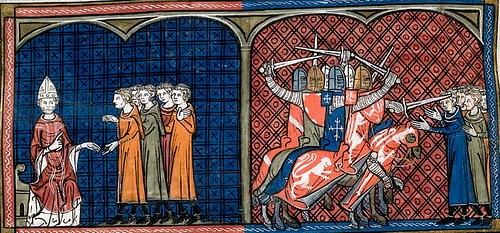
Waldensians (12th century) were a sect distinct from these previous three, founded in c. 1177 by Peter Waldo (l. c. 1140-1205) of Lyons, France. Waldo was a wealthy merchant who, seeking a closer relationship with God based on Christ's teachings, gave away his wealth and preached a doctrine of simplicity, poverty, and service to others. Prior to distributing his wealth to the poor, he paid for the Bible to be translated into Provençal, his native language, and preached Christ's message directly from that work. Waldo and his followers condemned the worldly aspects of the Church – most notably The Donation of Constantine which they felt contradicted Christ's teachings directly – as well as denying the validity of the sacraments (except for baptism and communion), the existence of purgatory, and veneration of the saints and the Virgin Mary. When Waldo appealed to Pope Alexander III (served 1159-1181) in 1179 for acceptance, he was not considered a heretic but was discouraged from preaching. Afterwards, however, the Waldensians were condemned for their criticisms of the Church, branded heretics, and fled to the mountains of Italy to escape persecution.
Lollards (14th century) were the followers of the English priest, philosopher, and Oxford professor John Wycliffe (l.1330-1384) who advocated for drastic reform of the Church. Their name may derive from a derogatory term applied to them by critics from the Dutch word for someone who mumbles prayers. John Wycliffe had the Bible translated from the Latin into Middle English, granting access to the scriptures to anyone who could read the vernacular. Wycliffe was protected by Oxford under academic freedom of expression, but after the Peasants' Revolt of 1381, in which at least one notable peasant leader was a Lollard, both the Church and State persecuted the sect. In 1395, the Lollards issued their document Twelve Conclusions of the Lollards which condemned, among other Church practices and policies, the Church's involvement with temporal affairs of state, celibacy of the clergy, sacerdotalism, payment for prayers for the dead, the Crusades, transubstantiation of the mass, veneration of saint's relics, and pilgrimages. They were persecuted throughout the 15th century but survived as an underground movement and emerged as a reputable sect after the English Reformation.
Hussites (15th century and afterwards) were followers of the philosopher and theologian Jan Hus (l. c. 1369-1415), rector of the Charles University in Prague, who admired Wycliffe's work and advocacy for reform. Hus and his followers frequently quoted Wycliffe's writings – which had been banned by the Church in the Kingdom of Bohemia – and based their own advocacy on his. Hus was not considered heretical until he objected to the selling of indulgences – writs purchased from the Church which reduced one's time in purgatory – which Wycliffe had also strongly objected to. Hus was brought to trial for his stand and other remarks he had allegedly made and was burned at the stake in 1415. His death ignited the Hussite Wars of 1419 - c. 1434 between Hussites and forces loyal to the Catholic Church. The Hussites survived the crusades against them and, like the Lollards, were justified during the Protestant Reformation.
Conclusion
A modern-day reader may find it difficult to understand why someone did not initiate serious reform earlier. The answer, as noted above, is the complete monopoly the Church held over the religious imagination of the people of Europe. It is easy to look back and recognize what should have been done differently and when, but even in one's own personal life, it is often quite difficult to see what needs to be done and act on it.
Unlike people in the modern era, those of the Middle Ages had limited options for spiritual expression. A French peasant was unlikely to embrace Islam when his Church consistently characterized Muslims as “devils” and even less likely to move toward Judaism as he would have been raised according to the Church's teachings that Jews were “Christ Killers” - though there are accounts of Christians embracing Judaism. Other options aside, the very real existence of hell – an eternity of unremitting torment – made spiritual salvation as vital as daily food and water.
The Church created a population which could not imagine existence without it and, although its early vision was beneficial and it provided a number of important services to the people, came to exploit its power and crush any dissent. It was only through the efforts of incredibly brave people, coupled with the spirit of the times which could no longer endure the Church's brutality, that the Protestant Reformation was launched and the power of the medieval Church broken.
